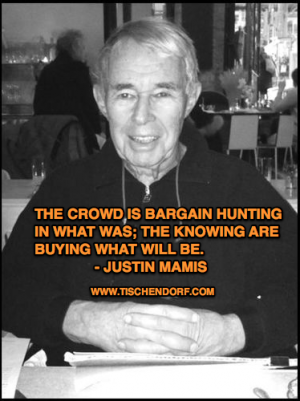A lot of people show interest in my book list and ask for advice on what to read. So without further ado another ‘quotes and excerpts’ post highlighting one of my favorite books.
Get exposure to new leaders —> Tischendorf Letter Premium
Tonight’s excerpt is from:
Justin Mamis: ‚When to Sell’ – Inside Strategies For Stock Market Profits ‘How Professionals Minimize Losses’ page 73-75:
Blaming ‚them’ is a psychologically and socially acceptable way to avoid blaming oneself. Yet professionals can, and do, make mistakes. When they buy a stock and it doesn’t go up (even if it doesn’t go down) that’s wrong enough for them, simply because it did not perform as expected. The pro reasons that the stock went against his judgement, so he sells it. And he doesn’t expect to be perfect, any more than a professional baseball player expects to bat 1.000. Knowing that losses are inevitable, he seeks to minimize them at all times. To be sure, his ability to take a small loss is enhanced by the benefit of not having to reckon with commission costs, but even so, if he were relatively incompetent he wouldn’t last long in the business; the loss might be less, or slower to pile up, but the return on invested capital would be dismal enough eventually to send him to another field.
Rule One of the professional trader is: When a stock doesn’t do what you expect it to do, sell it. No hesitating, no questions or doubts raised no conjectures of the way it should have turned out, or might still turn out, no dreams of how it will do what it was supposed to do ‚tomorrow’. The pro never says, ‚I’ll watch it one more day’. He doesn’t phone an analyst who’s been following the company and ask, ‚What’s happening? Is there any news?’ All too often , the delay in searching for the ‚why?’ is costly. The desire to be perfect is one of the prime bugaboos of the stock market, but it’s a compulsion that belongs on the psychiatrist’s couch, not on the exchange floor. And that means no berating yourself for having bought it, should it then go down, and no remorse for having sold should the stock turn around after you’ve gotten out and finally do what was expected.
We once watched a trader jettison an entire position because it had retreated half a point. ‚Not acting well’ he muttered at the time. But then, an hour later, there it was, roaring not only through his sale price but also through his original purchase price, and going higher still. The trader didn’t stop to berate himself; he immediately bought the stock again at the higher price. Since Wall Street is a game without end, he saw the situation for what it was: a brand-new chance.
Typically, though, the amateur confronted with the same sort of performance takes the stock’s behavior as a personal affront. Instead of dealing directly with the new information the tape is providing, he will stare disconsolately at the tape (or scowl at the newspaper tables the next morning), inveighing against the ‚they’ who stole his stock from him – and then got rich while he could only watch helplessly. Obviously, this is not how it is done. An unemotional, consistent program for minimizing losses is the sine qua non of selling efficiently. (The same, as we’ll discuss in more detail later in this chapter, is equally true of selling to capture your profit before a sagging stock takes it away from you.) Unless one accepts the inevitability of some loss, one is destined to wander in the world of would be, waiting, stock in hand , for tomorrow. Whereas one of the amateur’s most immediate concerns is not to look foolish, the professional’s foremost interest is not to be trapped with widening losses. He sells to be safe, to be able to keep on playing. To him selling is like taking out insurance on his capital. To be sure, you cannot always be as prompt as a professional who can leap the moment he sees one tick. Nor should you. You have more important things to do than watch a bunch of numbers all day. You cannot react to that single tick without having seen all that came before, just as you cannot settle for a half point profit. But adjustments can be made, and once you make them, you’re on the way to developing your own means of reacting to the market through a trader’s eyes.
Related Posts:
Investors are the big gamblers. They make a bet, stay with it, and if it goes the wrong way, they lose it all. – Jesse Livermore
The crowd is bargain hunting in what was; the knowing are buying what will be.
– Justin Mamis
Twitter: https://twitter.com/Tischendorf
Profit from 24+ years of active trading experience. Learn how to correctly interpret technical signals and get exposure to the best leading stocks:
Tischendorf Letter Premium

{ 16 trackbacks }
Comments on this entry are closed.